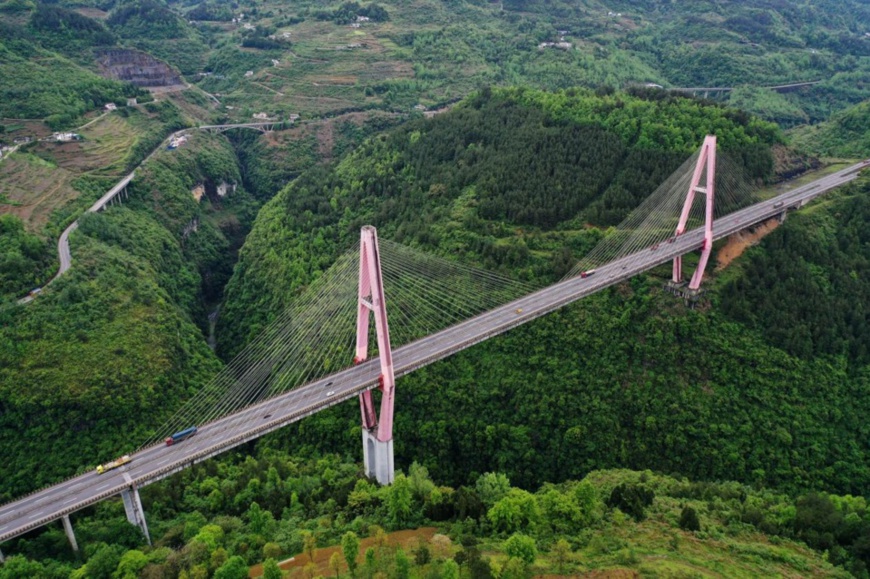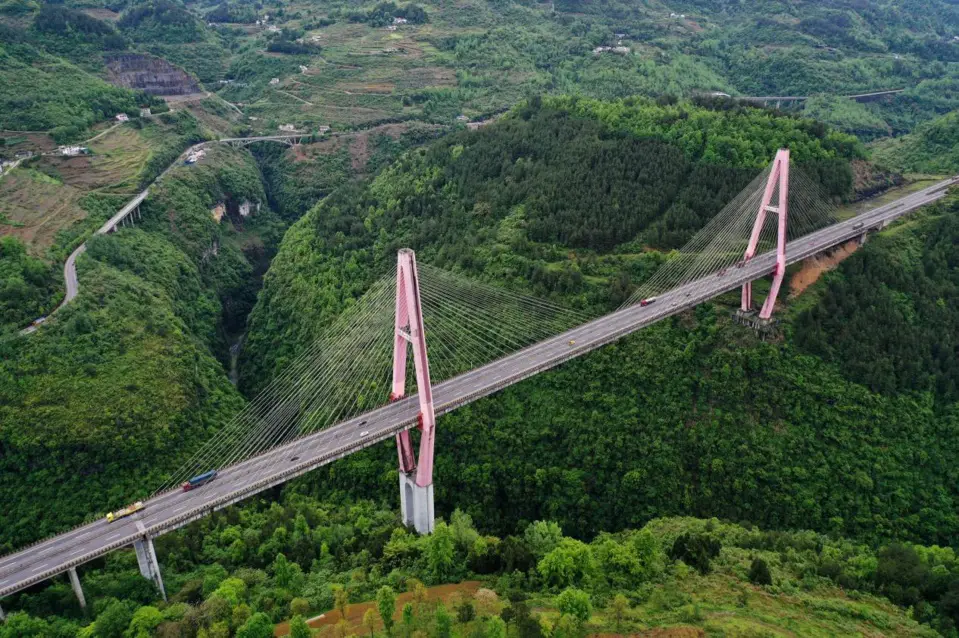By He Juan, People’s Daily

Photo taken on April 25, 2021 shows vehicles running on an 848-kilometer-long expressway connecting southwest China’s Chongqing municipality and Changsha, capital of central China’s Hunan province. The expressway links two major impoverished regions, the southeastern region of Chongqing and the western region of Hunan province. (Photo by Yang Min/People’s Daily Online)
As of the end of 2020, China’s total mileage of highways reached 160,000 kilometers. Highways in China, which have been built from scratch and developed rapidly over the past three decades, have become a great window on the development, changes, and achievements of China.
China’s highway network has witnessed the country’s resolve and strength to build highways wherever possible.
Since the implementation of the country’s reform and opening-up policy, especially since the 18th National Congress of the Communist Party of China (CPC) held in 2012, the construction of highways in China has experienced leapfrog development. By the end of 2020, almost all the Chinese cities with a population of over 200,000 had been covered by the country’s highway network.
The Beijing-Urumqi Expressway, which stretches from China’s capital city Beijing all the way west to Urumqi in Xinjiang Uygur autonomous region and spans the vast Gobi Desert, has reduced the road distance between Beijing and Urumqi by more than 1,300 kilometers.
The Ya’an-Xichang Expressway in southwest China’s Sichuan province, where half of the sections are rampways, winds along and passes through mountains and crosses over rivers, turning deep chasm into thoroughfare.
The Ningbo-Zhoushan Expressway in east China’s Zhejiang province connects islands through towering cross-sea bridges and opens up a lifeline for the islands in Zhoushan city of Zhejiang.
By prevailing over whatever challenges that lie ahead, unclogging bottlenecks, reconnecting disrupted links, and overcoming challenges, China has formed a highway network that links the eastern and western regions and runs through the northern and southern parts of the country.
Drive through China’s highway network, one can see the secret behind the country’s success in development. The country’s highways extending in all directions have generated opportunities for development.
The Guangzhou-Shenzhen Expressway, one of the busiest highways in the country, links China’s Hong Kong Special Administrative Region (HKSAR) and three cities of south China’s Guangdong province, namely Guangzhou, Dongguan, and Shenzhen.
With an average daily traffic flow of 650,000 vehicles, the expressway accelerates the integrated development of Guangdong and HKSAR, drives improvement in the layout of industries and economic restructuring of cities along the route, and facilitates the emergence of a world-class city cluster.
In more than ten provinces, autonomous regions, and municipalities of China, all the counties have been covered by highway network, thus smoothening the channel for promoting industrial products in the countryside and bringing farm produce to urban areas and offering a powerful driving force for rural vitalization.
Like a special bond between different parts of China, highways have formed a network that facilitates the flow of resources and sharing of opportunities, and allows different areas to complement each other’s advantages. Such a network has laid a solid foundation for the coordinated development of various regions and unimpeded circulation on the domestic market.
The highway network of China has mirrored the evolving development philosophy of the country.
Since 2012, many Chinese cities have attached more attention to old revolutionary base areas, areas inhabited by ethnic minority groups, border areas, and poor areas in the construction of highways. Relevant endeavors have not only helped these areas sell agricultural products throughout the country, but brought to these places talents, technologies, and other resources, providing strong support for building a moderately prosperous society in all respects. This is one of the best examples of the idea of shared development in the country’s new development philosophy.
In fact, highways in China not only mirror the country’s new development philosophy, but help promote the philosophy in various areas. Examples of the fact can be easily found in such efforts as removing all toll stations at provincial boundaries of national expressways to further lower logistics costs and improve the efficiency of road networks, giving priority to protecting important ecological functional zones to the greatest extent and keeping clear of ecologically sensitive areas in projects under construction, as well as seeking digital transformation and empowering highways with new technologies including big data, AI, blockchain, and supercomputing.
China’s highway network demonstrates the country’s confidence in its development in the future. Infrastructure construction plays an important role in driving economic growth and generates strong spillover effect. It can help reduce a country’s cost of economic circulation and improve the overall efficiency of economic operation.
Whether a country is capable of providing complete infrastructure shows its capabilities to mobilize resources, organize activities and implement plans.
China’s achievements in the construction of infrastructures such as highways and high-speed railways, while manifesting the country’s strong governance capacity, serve as an important cornerstone of China’s economic development.
Looking into the future, China aims to develop itself into a country with a strong transportation network and promote coordinated development of traditional and new forms of infrastructure, according to China’s latest blueprint for national development, the Outline of the 14th Five-Year Plan (2021-2025) for National Economic and Social Development and the Long-Range Objectives Through the Year 2035. Efforts made to realize the goal will no doubt lay a solid foundation for high-level self-reliance in science and technology and higher-quality development of the country.
China’s highway network has witnessed the country’s resolve and strength to build highways wherever possible.
Since the implementation of the country’s reform and opening-up policy, especially since the 18th National Congress of the Communist Party of China (CPC) held in 2012, the construction of highways in China has experienced leapfrog development. By the end of 2020, almost all the Chinese cities with a population of over 200,000 had been covered by the country’s highway network.
The Beijing-Urumqi Expressway, which stretches from China’s capital city Beijing all the way west to Urumqi in Xinjiang Uygur autonomous region and spans the vast Gobi Desert, has reduced the road distance between Beijing and Urumqi by more than 1,300 kilometers.
The Ya’an-Xichang Expressway in southwest China’s Sichuan province, where half of the sections are rampways, winds along and passes through mountains and crosses over rivers, turning deep chasm into thoroughfare.
The Ningbo-Zhoushan Expressway in east China’s Zhejiang province connects islands through towering cross-sea bridges and opens up a lifeline for the islands in Zhoushan city of Zhejiang.
By prevailing over whatever challenges that lie ahead, unclogging bottlenecks, reconnecting disrupted links, and overcoming challenges, China has formed a highway network that links the eastern and western regions and runs through the northern and southern parts of the country.
Drive through China’s highway network, one can see the secret behind the country’s success in development. The country’s highways extending in all directions have generated opportunities for development.
The Guangzhou-Shenzhen Expressway, one of the busiest highways in the country, links China’s Hong Kong Special Administrative Region (HKSAR) and three cities of south China’s Guangdong province, namely Guangzhou, Dongguan, and Shenzhen.
With an average daily traffic flow of 650,000 vehicles, the expressway accelerates the integrated development of Guangdong and HKSAR, drives improvement in the layout of industries and economic restructuring of cities along the route, and facilitates the emergence of a world-class city cluster.
In more than ten provinces, autonomous regions, and municipalities of China, all the counties have been covered by highway network, thus smoothening the channel for promoting industrial products in the countryside and bringing farm produce to urban areas and offering a powerful driving force for rural vitalization.
Like a special bond between different parts of China, highways have formed a network that facilitates the flow of resources and sharing of opportunities, and allows different areas to complement each other’s advantages. Such a network has laid a solid foundation for the coordinated development of various regions and unimpeded circulation on the domestic market.
The highway network of China has mirrored the evolving development philosophy of the country.
Since 2012, many Chinese cities have attached more attention to old revolutionary base areas, areas inhabited by ethnic minority groups, border areas, and poor areas in the construction of highways. Relevant endeavors have not only helped these areas sell agricultural products throughout the country, but brought to these places talents, technologies, and other resources, providing strong support for building a moderately prosperous society in all respects. This is one of the best examples of the idea of shared development in the country’s new development philosophy.
In fact, highways in China not only mirror the country’s new development philosophy, but help promote the philosophy in various areas. Examples of the fact can be easily found in such efforts as removing all toll stations at provincial boundaries of national expressways to further lower logistics costs and improve the efficiency of road networks, giving priority to protecting important ecological functional zones to the greatest extent and keeping clear of ecologically sensitive areas in projects under construction, as well as seeking digital transformation and empowering highways with new technologies including big data, AI, blockchain, and supercomputing.
China’s highway network demonstrates the country’s confidence in its development in the future. Infrastructure construction plays an important role in driving economic growth and generates strong spillover effect. It can help reduce a country’s cost of economic circulation and improve the overall efficiency of economic operation.
Whether a country is capable of providing complete infrastructure shows its capabilities to mobilize resources, organize activities and implement plans.
China’s achievements in the construction of infrastructures such as highways and high-speed railways, while manifesting the country’s strong governance capacity, serve as an important cornerstone of China’s economic development.
Looking into the future, China aims to develop itself into a country with a strong transportation network and promote coordinated development of traditional and new forms of infrastructure, according to China’s latest blueprint for national development, the Outline of the 14th Five-Year Plan (2021-2025) for National Economic and Social Development and the Long-Range Objectives Through the Year 2035. Efforts made to realize the goal will no doubt lay a solid foundation for high-level self-reliance in science and technology and higher-quality development of the country.
 Menu
Menu
 Highways become a fantastic window on China’s development, vitality
Highways become a fantastic window on China’s development, vitality
















